Coastal and Marine Geology
U.S. Geological Survey Fact Sheet 025-02
U.S. Coral Reefs—Imperiled National Treasures
|
Abstract Coral reefs
are home to 25% of all marine species. However, the tiny colonial animals
that build these intricate limestone masses are dying at alarming rates.
If this trend continues, in 20 years the living corals on many of the
world’s reefs will be dead and the ecosystems that depend on them
severely damaged. As part of the effort to protect our Nation’s extensive
reefs, U.S. Geological Survey (USGS) scientists are working to better
understand the processes that affect the health of these ecologically
and economically important ecosystems. |
 |
| The beauty and abundance of life in coral reef habitats, like this one in Florida, attract a variety of visitors, including sport divers and recreational fishermen. Such activities in U.S. waters alone generate billions of dollars a year for the tourist industry. (Copyrighted photograph courtesy of Sandra Edwards.) |
In recent decades, many of the world’s coral reefs have been severely damaged by both natural processes and human activities. The reasons for the catastrophic decline in the health of these complex marine ecosystems are poorly understood. Coral reefs are home to 25% of all marine species, and it is crucial that they be protected. Coral reef habitats contribute hundreds of millions of dollars annually to the United States fishing industry and help generate billions of dollars a year for the Nation’s tourist industry.
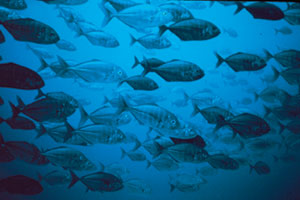 |
| A large school of jacks swims in Poka‘i Bay, O‘ahu, Hawaii. Coral reefs in Hawaii and elsewhere provide shelter and nursery grounds for many commercially and culturally important species of fish and invertebrates. Such reef habitats contribute hundreds of millions of dollars a year to the United States fishing industry. (Photograph courtesy of National Oceanic and Atmospheric Administration/James P. McVey.) |
To preserve and protect the biodiversity, health, and social and economic value of coral reef ecosystems in the United States and its territories, the U.S. Coral Reef Task Force was established by Executive Order in 1998. The task force is a cooperative effort among Federal agencies, state agencies, and academic institutions and is co-chaired by the U.S. Secretaries of Interior and Commerce.
There are extensive coral reefs in the waters of the United States and its territories, covering more than 4 million acres of the sea fl oor in the Atlantic Ocean, Gulf of Mexico, Caribbean Sea, and the Pacifi c Ocean. More than 60% of the Nation’s coral reefs are found in the extended Hawaiian Island chain. Most of these are included in the recently designated Northwestern Hawaiian Islands Coral Reef Reserve, the largest U.S. nature preserve.
| U.S. Coral Reefs | |
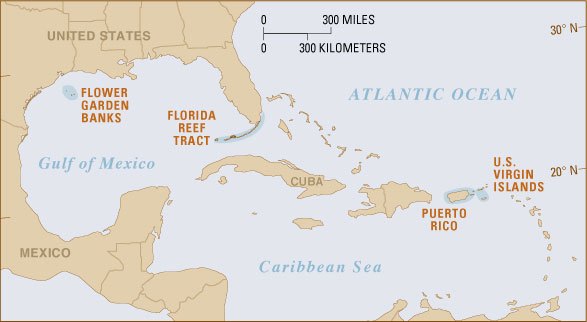 |
Extensive coral reefs are found in the waters of the United States and its territories. In the Atlantic Ocean, Gulf of Mexico, and the Caribbean Sea these include reefs off Florida, Texas, Puerto Rico, and the U.S. Virgin Islands. In the Pacific Ocean, they include those of the Hawaiian Islands, Wake Island, Johnston Atoll, the Northern Marianas, Saipan, Guam, Kingman Reef and Palmyra Atoll, Howland Island, Baker Island, Jarvis Island, and American Samoa. More than 60% of the Nation’s coral reefs are found in the extended Hawaiian Island chain. |
 |
|
What is
a reef?
The word “reef” has different meanings to different people. To a mariner, the term “reef” applies to shallowly submerged navigational hazards. To a surfer, a reef is an undersea obstruction that can make waves (and surfboards) break. Geologists and biologists generally restrict the defi nition of a reef to rigid biological constructions that have formed in shallow water. The Earth’s fi rst reefs were built by photosynthesizing cyanobacteria about 2.5 billion years ago. From fossil remains, it is known that a variety of organisms have constructed reefs, including bivalves (clams and oysters), bryozoans (coral-like animals), and sponges. Corals have been found in fossil reefs as old as 500 million years, but corals similar to modern colonial varieties have constructed reefs only during the past 60 million years.
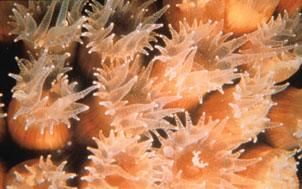 |
Corals are marine animals related to jellyfish and anemones. Coral polyps, the individual animals that make up both colonial and solitary corals, catch plankton (microscopic plants and animals) and other suspended food particles with arm-like tentacles, which feed a centrally located mouth. Coral reefs are formed by colonies of “hard” corals that secrete calcareous exoskeletons, giving them structural rigidity. (Photograph courtesy of Florida Keys National Marine Sanctuary.) |
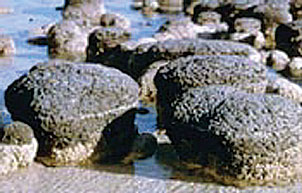 |
To scientists the word “reef” refers to rigid biological constructions that have formed in shallow water. The Earth’s first reef-building organisms lived about 2.5 billion years ago and were photosynthesizing cyanobacteria that built stromatolites like these modern ones in Shark Bay, Australia (top, courtesy of the Australian Heritage Commission). Much of North America was once covered by tropical seas that were home to many species of coral. Fossil corals, such as this one from Tennessee (bottom), have been found in ancient reefs as much as 500 million years old, but modern colonial varieties of coral have constructed reefs only during the past 60 million years. |
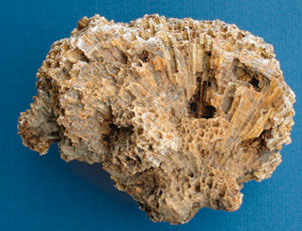 |
What is
a coral reef?
Corals are marine animals related to jellyfish and anemones. Both colonial and solitary corals catch plankton (microscopic plants and animals) and other suspended food particles with arm-like tentacles, which feed a centrally located mouth. Most hard corals also host symbiotic algae, a long-standing and successful partnership. These algae provide them with an additional food source through photosynthesis. Coral reefs are formed by corals that secrete hard calcareous (aragonite) exoskeletons, giving them structural rigidity. These colonial “hard corals” form elaborate fi nger-shaped, branching, or moundshaped structures and can create masses of limestone that stretch for tens or even hundreds of miles.
Although corals have a wide distribution in the world’s oceans, the varieties that form reefs are typically restricted to relatively shallow, warm tropical waters between latitudes 30° north and 30° south. Clean, clear water is essential to their health. Once coral larvae settle on a hard substrate and become established, colonies can arise if conditions are suitable for growth. Given enough time, coral colonies become thickets. As coral thickets build upward on the skeletal remains of older colonies, a reef is established. Today, richly diverse coral reefs are found in the tropics along coastlines, on the margins of volcanic islands, and as isolated coral atolls.
Why are coral reefs in peril?
Coral reefs can be damaged by natural processes, such as storms, but they are increasingly at risk from human activities. Coral reef health can be seriously affected and the growth of new colonies hampered by fi ne-grained sediment transported from land into coastal waters as runoff. This sediment runoff can be greatly increased by nearby land developments for agriculture, industry, and housing. Light necessary for photosynthesis by symbiotic algae living in corals is diminished in waters made cloudy or turbid by suspended sediment, reducing coral productivity.
|
CORAL REEFS DEVELOP IN CLEAR WARM SEAS . . . |
|
| Colonial “hard corals” form elaborate finger-shaped, branching, or mound-shaped structures and can create masses of limestone that stretch for tens or even hundreds of miles. Many coral reefs fringing coasts consist of nearshore inner reef flats that slope to deeper water fore reefs farther offshore. The reef crest, between the inner reef flat and outer fore reef, lies in extremely shallow water and may be exposed during the lowest tides. Waves commonly crash against or break on the reef crest. Fringing reefs help to protect harbors, beaches, and shorelines from erosion and wave damage by storms. |
|
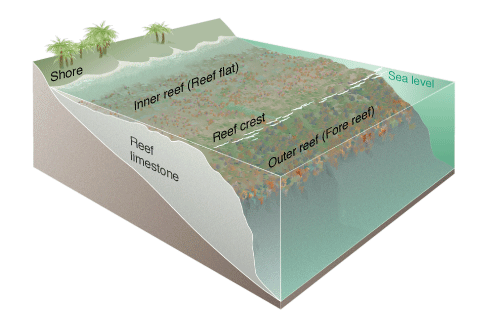 |
|
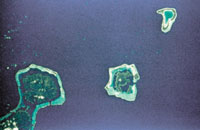 |
|
| Coral atolls develop from reefs fringing volcanic islands (diagrams at right). As first hypothesized by Charles Darwin, and confi rmed by ocean drilling done by British scientists a century ago, reefs fringing volcanic islands build vertically to sea level, forming steepwalled barrier reefs. As a volcanic island subsides, or sinks, with time, the growing reef keeps pace with the rising water level. When the island eventually submerges, the ring-shaped reef forms an atoll with a central lagoon. The NASA Landsat 7 satellite image at above shows Pacific islands with fringing reefs and an atoll. | |
Corals face serious risks from various diseases, including black-band, white-band, and yellow-band diseases that have been reported from many localities worldwide. Black-band disease is primarily caused by cyanobacteria, but the causes of white-band disease and yellow-band disease are unknown. When corals are stressed, they often expel the algal symbionts that are critical to their health in a process commonly known as coral bleaching. One known cause of coral bleaching is increases in ocean temperatures. Regional increases in sea-surface temperatures occur during El Niño events, and ocean temperatures worldwide may be changing as a result of global warming.
The susceptibility of corals to disease may be on the rise as a result of human activities. Many human activities are known to directly and indirectly harm coral reefs. Oil spills and pollutants can threaten entire reefs. Excessive nutrients from land sources, such as sewage outfall and agricultural fertilizers, promote the growth of algae that can smother corals. Such algae also thrive when fish that graze on them are overharvested. Other organisms harmful to corals, such as crown-of-thorns starfish, multiply when the species that prey on them are removed. The collection of live corals and other reef organisms can directly degrade large areas of reef.
|
U.S. GEOLOGICAL SURVEY SEA-FLOOR MAPPING HELPS ASSESS REEF HEALTH |
||
| The data used to create this 3-D perspective image of West Flower Garden Bank, in the Gulf of Mexico, were collected and processed by U.S. Geological Survey scientists using multibeam sea-floor mapping techniques. Such techniques provide important information about a number of coral reef characteristics that can be used to help evaluate and monitor changes in reef health. The shallowest areas shown in the image (red) reach to within 60 feet of the water’s surface and support a coral reef environment, home to a richly diverse web of life (see photos, copyrighted and courtesy of David M. Read). | 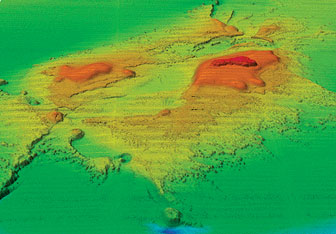 |
|
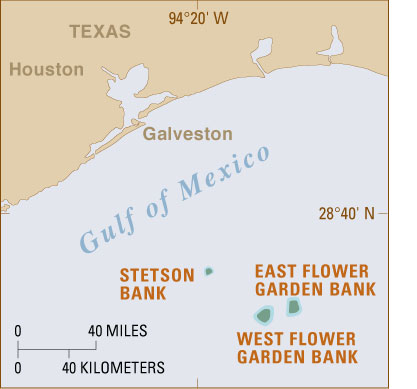 |
 |
|
 |
||
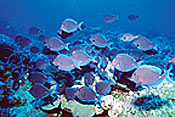 |
||
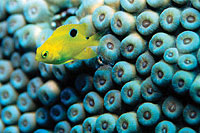 |
 |
|
| CORAL REEFS FACE MANY SERIOUS THREATS | |
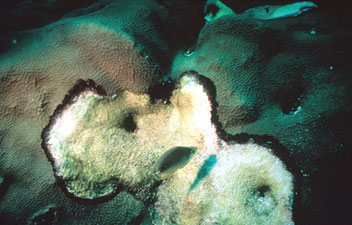 |
Corals face serious risks from various diseases, including black-band disease. The susceptibility of corals to disease may be on the rise as a result of human activities. Many human activities are also known to directly and indirectly harm coral reefs. Excessive nutrients from land sources, such as sewage outfall and agricultural fertilizers, promote the growth of algae that can smother corals. Such algae also thrive when fish that graze on them are overharvested. Other organisms harmful to corals, such as crown-of-thorns starfish, multiply when the species that prey on them are removed. [Photographs courtesy of Florida Keys National Marine Sanctuary/ Page Gill (black-band disease); National Oceanic and Atmospheric Administration (soil runoff, Hawaii); and Fagatele Bay National Marine Sanctuary, American Samoa/Kip Evans (crown-of-thorns starfish).] |
| Black-band disease, Florida | |
|
Soil runoff, Maui, Hawaii |
|
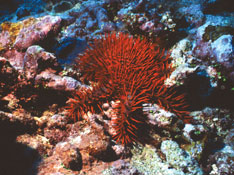 |
|
| Crown-of-thorns starfish, American Samoa | |
What is being done to protect coral reefs?
Scientists worldwide are working to understand the impacts of natural processes and human activities on the health and sustainability of coral reefs. In the United States, this effort is being coordinated by the U.S. Coral Reef Task Force. As part of the task force, the U.S. Geological Survey (USGS) is contributing to the effort to understand the biological and geological controls that affect our Nation’s coral reefs. USGS coral reef research focuses on detailed mapping of reefs, the development of monitoring techniques, and studying reefs’ geologic growth and development and how they are affected by sedimentary and hydrologic processes, water quality, and fi shing. These efforts will help provide information that is essential if coral reefs are to be saved.
Michael E. Field, Susan A. Cochran, and Kevin R. Evans
Edited By James W. Hendley II and Peter Stauffer
Graphic Design By Susan Mayfield and Sara Boore; Web layout by Carolyn Donlin
For more
information contact:
U.S. Geological Survey
Pacifi c Science Center
1156 High Street
Santa Cruz, CA 95064
(831) 427-4745
See also New Mapping
Techniques Help Assess the Health of Hawaii’s Coral Reefs (USGS
Fact Sheet 084-01).
Download this 4-page fact sheet as a PDF file (1.2 MB)
Download a free copy of the latest version of Adobe Reader.
| Help | PDF help | Geopubs main page | Fact Sheets |
| Geologic Division | Coastal and Marine Geology |